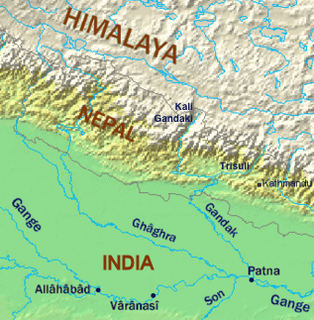 W
WThe Kingdom of Nepal, also known as the Kingdom of Gorkha or Gorkha Empire or Asal Hindusthan, was a Hindu kingdom on the Indian subcontinent, formed in 1768, by the unification of Nepal. Founded by King Prithvi Narayan Shah, a Gorkhali monarch who claimed of Rajput origin from medieval India, it existed for 240 years until the abolition of the Nepalese monarchy in 2008. During this period, Nepal was formally under the rule of the Shah dynasty, which exercised varying degrees of power during the kingdom's existence.
 W
WBaise Rajya were sovereign and intermittently allied petty kingdoms on the Indian subcontinent, ruled by Khas from medieval India, located around the Karnali-Bheri river basin of modern-day Nepal. The Baise were annexed during the unification of Nepal from 1744 to 1810. The kingdom's founder Prithvi Narayan Shah did not live to see this, but his son and grandson annexed the entire collection by the end of the 18th century.
 W
WThe King of Nepal was Nepal's head of state and monarch from 1768 to 2008. He served as the head of the Nepalese monarchy—Shah Dynasty. The monarchy was abolished on 28 May 2008 by the 1st Constituent Assembly. The subnational monarchies in Mustang, Bajhang, Salyan, and Jajarkot were abolished in October of the same year.
 W
WThe Nepalese royal massacre occurred on 1 June 2001, at the Narayanhiti Palace, the then-residence of the Nepalese monarchy. Nine members of the royal family, including King Birendra and Queen Aishwarya, were killed in a mass shooting during a gathering of the royal family at the palace. A government-appointed inquiry team named Crown Prince Dipendra as perpetrator of the massacre. Dipendra slipped into a coma after shooting himself.
 W
WPrithvi Bir Bikram Shah was King of Nepal from 1881 until 1911. Among the most notable events of his reign were the introduction of the first automobiles to Nepal, and the creation of strict water and sanitation systems for much of the country. King Prithvi's eldest child was Princess Royal Lakshmi Rajya Lakshmi Devi, who was married to Field Marshal Kaiser Shamsher Jang Bahadur Rana. She was made the Crown Princess and was heir to Nepal's throne until she was in her late teens, when her brother King Tribhuvan Bir Bikram Shah Dev was born. Until then King Prithvi only had four daughters and four from another wife.
 W
WThe Shah dynasty, also known as the Shahs of Gorkha or the Royal House of Gorkha, was the ruling Chaubise Thakuri dynasty from the Indian subcontinent; and derived from the Gorkha Kingdom from 1559 to 1768 and later the unified Kingdom of Nepal from 1768 to 28 May 2008.
 W
WTribhuwan Bir Bikram Shah was King of Nepal from 11 December 1911 until his death. Born in Kathmandu, the capital city of Nepal, he ascended to the throne at the age of five, upon the death of his father, Prithvi Bir Bikram Shah, and was crowned on 20 February 1913 at the Nasal Chowk, Hanuman Dhoka Palace in Kathmandu, with his mother acting as regent. At the time of his crowning, the position of monarch was largely ceremonial, with the real governing power residing with the Rana family.